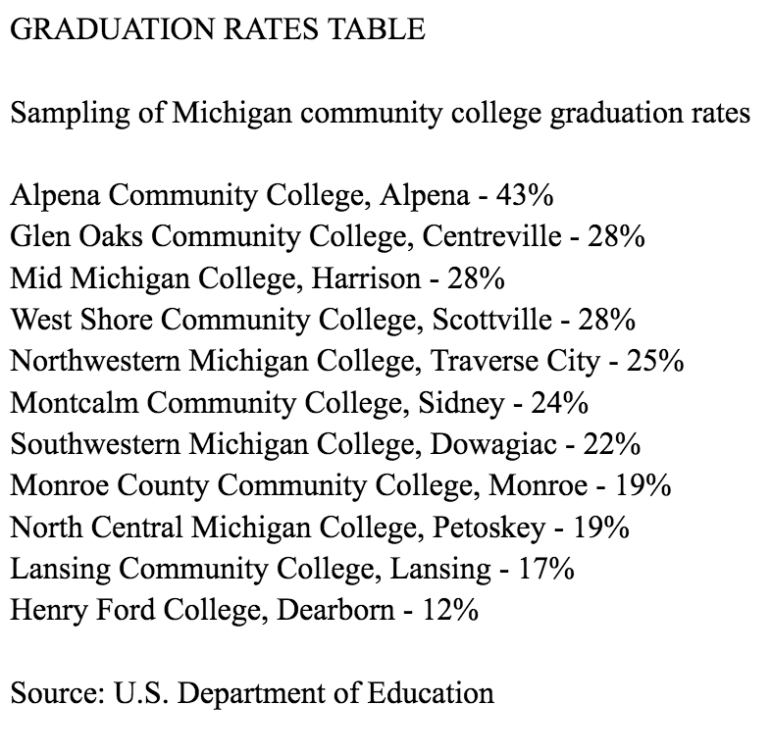By HOPE O’DELL
Capital News Service
LANSING – For community colleges, graduation rates aren’t always clear markers of a successful institution, said Erica Orians, the executive director of the Michigan Center for Student Success at the Michigan Community College Association.
“It’s very hard to apply one rule to all of the colleges and universities across the country,” she said. “What’s really crucial is to look at an institution’s mission.”
For many community colleges across the state, graduation from their programs isn’t the most common –– or most beneficial – outcome for many students.
For Orians, raising graduation rates isn’t the goal – lowering barriers to access is.
The U.S. Department of Education tracks graduation rates for every college in the country, but Orians said the data is for only a specific set of students – full-time, first-time, degree seekers who stay at the first place they enroll.

U.S. Department of Education
Graduation rates for a sampling of community colleges in Michigan: Alpena, Lansing, Sidney, Scottville, Harrison, Centreville, Traverse City, Petoskey and DearbornStudents who transfer from one school to another are counted as dropouts from their first school and not counted in the second institution’s graduation rate.
Orians said that leaves out a large chunk of those who go to community college, those who often aren’t first-time students, may not be full time and may plan to transfer to a four-year university. Students who transfer before completing their community college’s program are counted as a dropout in graduation rates.
Orians said only a quarter of transfer students earn an associate degree before transferring.
That explains why even the Michigan community college with the highest graduation rate, according to the Education Department, Alpena Community College, is only 43%, Orians said.
It also explains some low rates, like that of Henry Ford College in Dearborn at 12%, the lowest in the state.
The graduation rate at Glen Oaks Community College in Centreville sits in the middle of the pack at 28%.
Tammy Russell, the Glen Oaks executive director of institutional planning, assessment and research said that’s because 55% of its students are dual-enrolled high schoolers, but 55% of them didn’t finish a degree there.
But Russell said students, whether they graduate from Glen Oaks before finishing high school or not, are more likely to graduate college. This is especially true for those who are historically disadvantaged –– students of color, rural students and first-generation students.
“Students who begin postsecondary education with credits already under their belt have better outcomes,” she said. “They persist and graduate at higher rates.”
Russell said 45% of Glen Oaks students transfer to four-year institutions within six years of leaving the community college, regardless of whether they earned an associate degree from Glen Oaks.
But when it comes to graduating and transferring, Russell said community college students face many challenges, most of them unrelated to their studies.
“Unfortunately, students have to make decisions based on their individual and family circumstances,” she said. “Too often, this results in students dropping out of college.”
Orians and the Center for Student Success also express concern about the nonacademic barriers many community college students face, primarily underpreparation for college-level courses, whether credits transfer and basic needs like housing and food.
One solution for underprepared students is called “requisite remediation,” where students take college-level courses along with lower-level courses to catch up.
Michigan doesn’t have a state system to coordinate higher education, and that can make it difficult for students to understand what credits transfer to which schools, Orians said.
The Center for Student Success coordinates between community colleges and universities to make sure credits transfer, she said.
“We have designed and created about 10 statewide transfer articulation agreements in some of the most popular majors in Michigan,” she said. “So students can start at a community college and transfer to any participating university.”
These agreements are on top of the already existing Michigan Transfer Agreement, which allows students to transfer credits between participating institutions. All 15 public universities in the state participate.
To address basic human needs, Orians said most community colleges have robust food pantries that expand to provide other necessities like toiletries, and have expanded their emergency assistance funds for students who face unexpected expenses, like when their cars break down.
“Colleges can play a really significant role in connecting students with resources that can help with those issues,” she said.